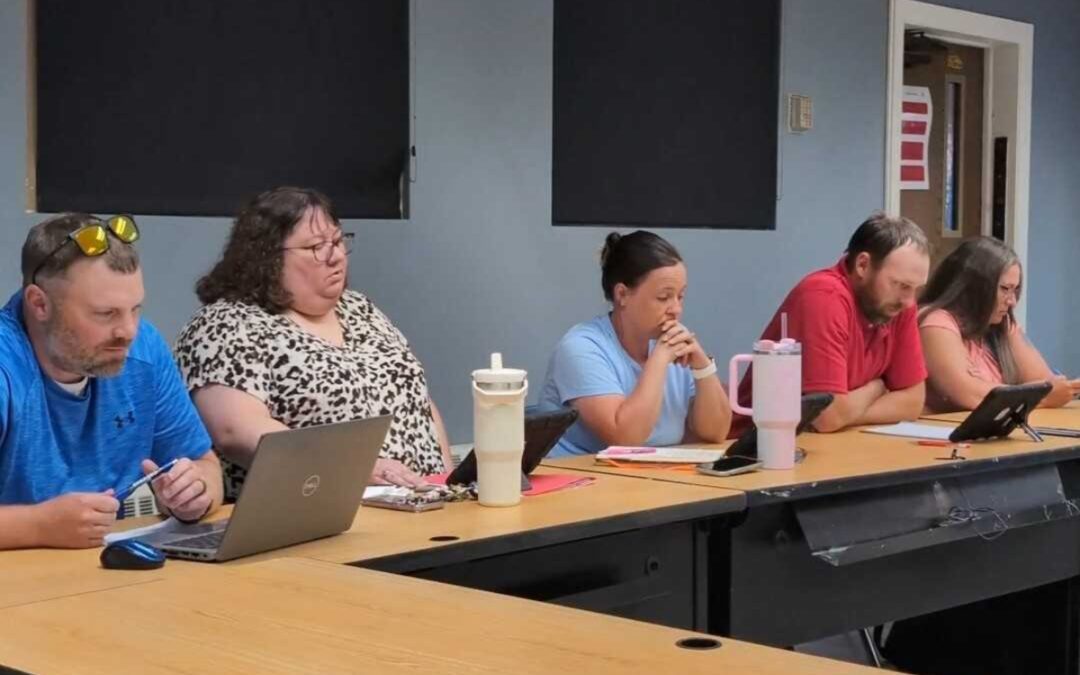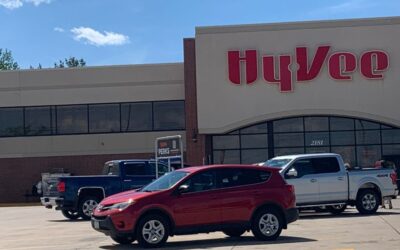
Scenes from the North Liberty wastewater treatment plant. Photos by Ty Rushing/Starting Line
“Nobody graduates high school and says, ‘I want to be a wastewater operator,’” said Drew Lammers, who found his calling as the superintendent of the award-winning North Liberty wastewater treatment plant and encourages others to give the industry a chance.
Lammers shared that remark with Rep. Amy Nielsen (D-North Liberty) and me on a recent tour of the facility that Nielsen arranged for us after I noted on Twitter that visiting wastewater plants “is a surprisingly fun news assignment.”
In addition to being a longtime resident, Nielsen is also a former mayor of the fast-growing Johnson County community and is proud of its facilities, including the five-year-old water treatment facility that includes a plaque with her name on it.

Rep. Amy Nielsen (D-North Liberty) points to her name on a plaque commemorating North Liberty’s new water treatment plant. Photo by Ty Rushing/Starting Line
The North Liberty wastewater plant serves everyone in the community of about 22,000 residents. Whatever North Libertians flush down the toilet—please don’t flush “flushable” wipes—visits the plant before it is thoroughly treated and redirected into the nearby Muddy Creek.
“For most folks, wastewater is out of sight, out of mind. If [the city] council or the public doesn’t hear from us, it’s probably a good thing,” Lammers said.
Lammers leads a seven-person team at the wastewater plant and said his uncle told him about the benefits of a career in wastewater: You can get your license in about two years, you can work anywhere, and it’s stable and allows you to provide for your family.
So about 15 years ago, Lammers switched from studying business administration to wastewater and he has flourished ever since.
After starting as an intern at the North Liberty plant, where he was trained by current operations supervisor Mark Farrier, Lammers rose to the rank of supervisor. Farrier, who is in his second stint on the team, left the plant and the country to take on a few new challenges but was hired back by Lammers years later when he and his family returned to Iowa.
Like most public employees, Lammers and Farrier take pride in their work. It was enlightening to learn more about their jobs and the North Liberty wastewater plant, which is one of the most unique in the state and, at one point, was the only plant of its type in the Midwest.

Superintendent Drew Lammers explains how they can monitor activity at the North Liberty wastewater treatment plant through the operating system being shown on screen. Photo by Ty Rushing/Starting Line
Originally built in 1998, the wastewater plant underwent a $8.4 million renovation/expansion in 2008. This process got the plant up to code, enabled it to handle the growing population of North Liberty (the city’s population was about 5,400 in 2000), and converted it from an activated sludge plant to one that uses a membrane bioreactor (MBR) process.
MBR plants use thousands of membranes bundled together to separate solids and liquids through a hyperfiltration system while leaving behind the “sludge.” Each membrane is a hollow-fiber tube with small holes on the outside that are almost naked to the eye, and the membrane strands kind of resemble spaghetti noodles.
Lammers said in a typical wastewater plant, you have a large clarifier tank. The tank takes up a huge footprint and it is where wastewater is collected. Whenever a new gallon of wastewater enters, a gallon of clean water comes out as the solids settle at the tank’s bottom, and the clean water is then disinfected.
“We skip all of that process,” Lammers said. “We biologically treat [wastewater], we run that biologically treated water right past these membranes, and these membranes will suck the water molecule right essentially leaving mud behind,” he continued.
The leftover mud, or biosolid, is dewatered into a gelatin-like consistency—called a “dry cake”—that is easy to transport and stored at another facility on the grounds. The dry cake is eventually sold off to be used as field fertilizer for farmers.

This biosolid is a byproduct after waste is treated at the North Liberty wastewater treatment plant. It can be used to fertilize farm fields. Photo by Ty Rushing/Starting Line
At this point, you’re probably thinking this assignment stinks metaphorically and literally, but you would be wrong! Seriously, there is a school down the street from the plant and you smell nothing as you drive past it and pull up to the gated facility that houses the plant.
The reason for this is that the North Liberty plant treats water through an aerobic process, which reduces odor significantly.
Here’s how Veolia, the company that supplies North Liberty with its membranes, describes this method: “Aerobic treatment of wastewater is a biological process that uses oxygen to break down organic contaminants and other pollutants like nitrogen and phosphorous. Oxygen is continuously mixed into the wastewater or sewage by a mechanical aeration device, such as an air blower or compressor.”
Now, there is a slight musty smell in the building where this process takes place, but it’s nothing to write home about. That said, you probably should not open the dumpster where the non-biological waste is collected.
“That’s the worst-smelling part of the tour,” Farrier said. “But, if something goes wrong and our tanks go anaerobic, they usually start having an odor. So sometimes I’ll drive into the plant and I’ll be like, ‘Ohhhh, what happened.’”
Farrier said on those rare occasions, it’s usually something minor such as the oxygen being turned off or a broken belt on a blower.
During the tour, they talked about good times—like Lammers learning first-hand how different working at a wastewater treatment plant was compared to what he learned in school—to not-so-good times, such as the facility being flooded and having a small fire last year.

In 2022, this room at the North Liberty wastewater treatment flooded and caught on fire. Photo by Ty Rushing/Starting Line
They talked about how their crew does everything from mowing the grass to cleaning the toilets at the plant site and future phases for the plant, which last underwent an expansion in 2018 to accommodate North Liberty’s continued growth.
Still, one thing gnawed at me. At the end of the tour, I asked Lammers to elaborate on the comment he made about no high school graduates seeking work in the wastewater treatment plant. He responded by sharing what he and his guys are doing to change that perception.
“It’s been a great industry,” Lammers said. “That’s why we join groups to try to give outreach to students, we give tours, and have people come see this stuff. The city spends a lot of money on upkeep on this nice facility and to stay up on all the rules and regulations, so we like to show it off and present it and let people know this isn’t the only place you can get a wastewater job.”
Lammers also tries to clear up misnomers about wastewater work. He noted it involves plumbing, lab work, math, and budgeting, and that you have to become a Jack-of-all-trades to thrive in the industry.
“Go into it with an open mind and it’s not, ‘I’m going to go to work and shovel shit all day long,’ there’s a lot of technical stuff to this,” he said.

Opinion: We must help communities that have been left behind, no matter who wins in November
In this op-ed, Justin Maxson and Sarah Jaynes advocate for prioritizing federal investments to uplift all communities and ensure widespread economic...

Miller-Meeks contorts herself on Trump and Hunter Biden convictions
Republican Iowa congresswoman agrees with Hunter Biden’s conviction, but minutes later, she said she has “great concerns” about Donald Trump's...

Orient-Macksburg officials move forward with plan to close Iowa school district
Orient-Macksburg School Board approves the resolution to dissolve, but voters will make the final decision. Silence filled the room after...

Lanon Baccam wins 3rd District Dem primary, will face Zach Nunn
Baccam defeats Melissa Vine to challenge Republican incumbent Lanon Baccam defeated Melissa Vine in Tuesday’s Democratic primary for Iowa’s 3rd...

Hardin County man running for office as Trump-loving Democrat to local party’s dismay
Brad Rewoldt, who recently changed his party affiliation from Republican, says his support of Trump will probably 'piss off' Democrats There is a...

Hy-Vee will close stores in Cedar Rapids, Waterloo, Davenport, creating food deserts
Midwest grocery chain Hy-Vee is closing three stores in low-income neighborhoods, which will have the effect of creating three new food deserts in...





